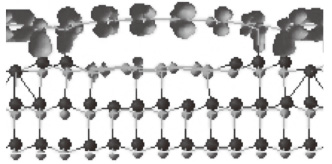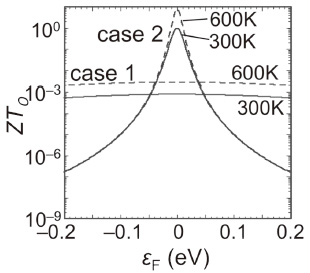Yoshiaki Sekine1, and Hiroshi Yamaguchi1
1Physical Science Laboratory, 2Materials Science Laboratory, 3The University of Tokusima
Graphene is atomically thin two-dimensional sheet. Because of this unique
structure, it is expected to show various novel properties. We theoretically
study its potential [1-3].
Magnetoelectric effect controls magnetism by external electric field [1,
3]. Graphene edge with the zigzag structure is theoretically predicted
to show magnetism. However, the magnetism is difficult to be realized if
the graphene is located on SiO2 substrate, because the edge should be appropriately terminated by H atoms.
On the other hand, in case of epitaxial graphene on SiC(0001) substrate,
experiments show that islands of graphene are already formed in the initial
stage of the growth by the high-temperature annealing. In addition, it
is theoretically revealed that the island edge is already connected seamlessly
to the SiC substrate (Fig. 1). Therefore, the edge is not necessary to
be terminated by H atoms. Since the epitaxial graphene is also negatively
charged due to the interaction with the substrate, and since the edge magnetism
requires the charge neutrality, the island with the zigzag structure edge
shows magnetism, only when the application of external field by a gate
electrode induces positive charge to neutralize the epitaxial graphene.
In this way, the magnetism appears by the magnetoelectric effect for the
graphene islands on SiC (Fig. 1).
Thermoelectric effect induces the potential difference from the temperature
difference. It is useful for the electric power generation from wasted
heat [2, 3]. The conventional graphene on SiO2 substrate shows the thermoelectric figure of merit ZT0 of the order of 10-3, which means high difficulty for the practical use. However, if the density of ionic adsorbates on graphene is reduced by 1/1000 times and the optical phonon scattering from the substrate is suppressed significantly, the graphene is expected to exhibit the figure of merit ZT0 over 1 around the charge neutrality point, which means the strong possibility for the practical use (Fig. 2). Graphene is plentiful, cheap, harmless, and low in specific gravity. Therefore, graphene is a good candidate for a practical thermoelectric conversion material.
This work is partly supported by KAKENHI.
[1] H. Kageshima et al., Appl. Phys. Express 3 (2010) 115103.
[2] H. Kageshima, Jpn. J. Appl. Phys. 49 (2010) 100207.
[3] H. Kageshima et al., Jpn. J. Appl. Phys., in press.
 |
 |
|||||
|
|